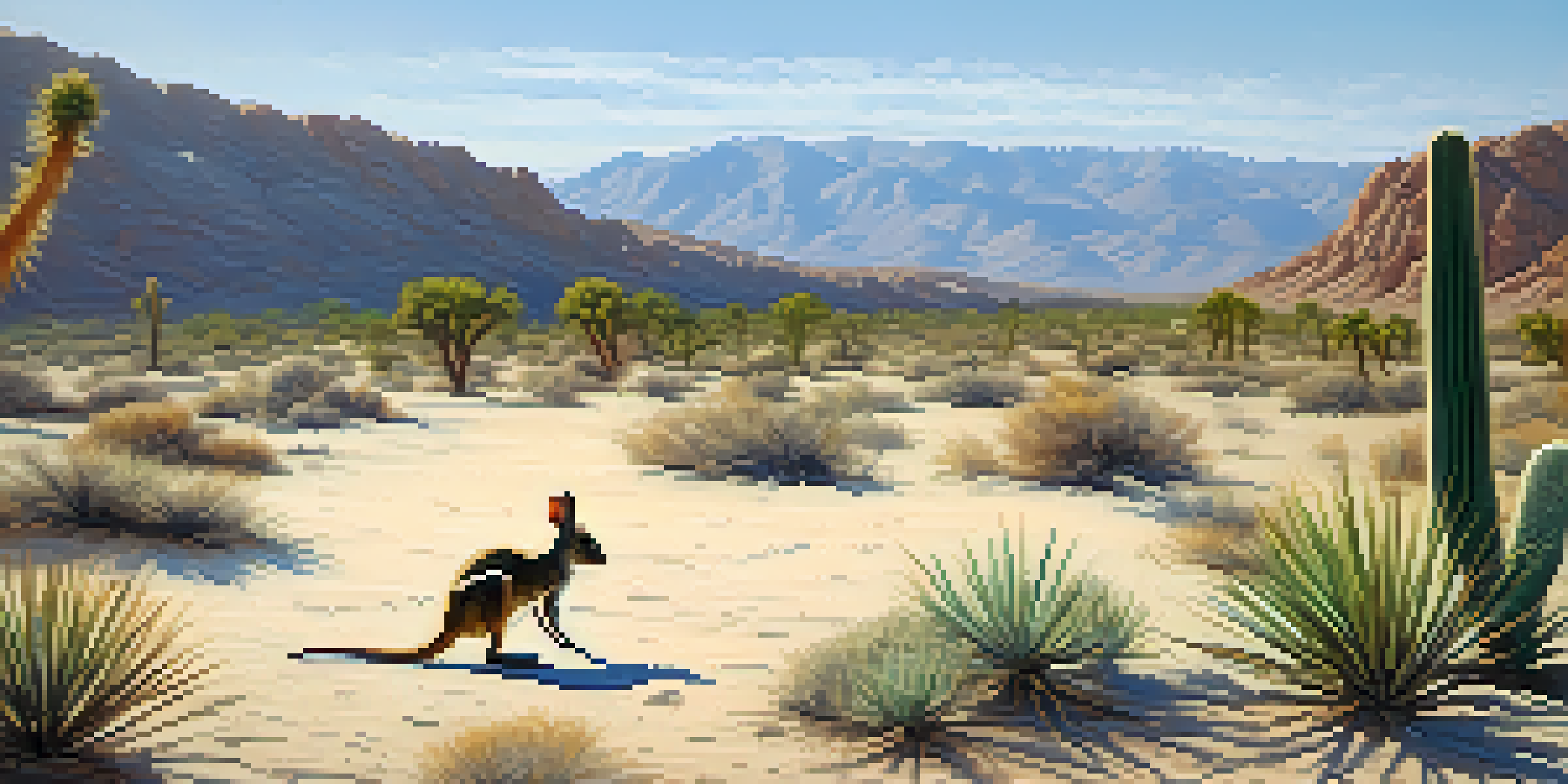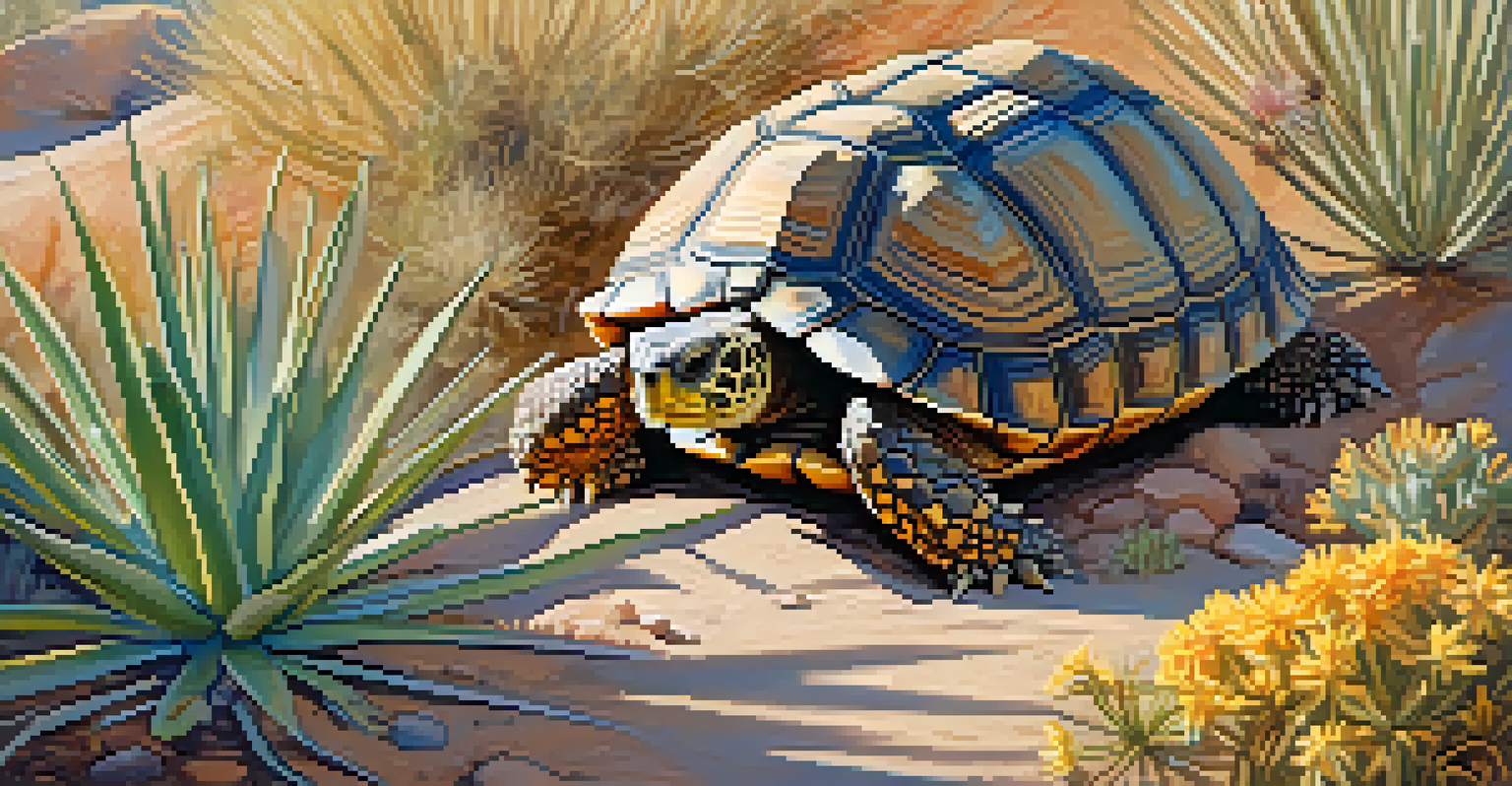Adaptations of Desert Fauna in Palm Springs' Harsh Climate

The Harsh Climate of Palm Springs and Its Challenges
Palm Springs is known for its scorching temperatures and arid conditions. With summer highs often exceeding 100°F, desert fauna face significant challenges in survival. Limited water sources and extreme temperature fluctuations make it a tough environment for wildlife.
In every walk with nature one receives far more than he seeks.
In such a harsh climate, animals must adapt to conserve water and regulate their body temperatures. This adaptation process is fascinating, as it showcases the resilience of life in one of the most unforgiving ecosystems on Earth. Understanding these adaptations gives us insight into the delicate balance of desert life.
For instance, during the blistering heat of midday, many desert animals become inactive, opting for a strategy known as 'estivation.' This behavior allows them to avoid the worst of the heat, emerging during cooler periods to feed and drink. Such survival strategies highlight the remarkable ingenuity of nature.
Water Conservation: A Key Adaptation
Water is a precious commodity in the desert, and many Palm Springs fauna have adapted remarkable methods to conserve it. For example, the kangaroo rat can survive without ever drinking water, extracting moisture from the seeds it consumes. This adaptation is vital in a habitat where water is scarce.

Additionally, some species, like the desert tortoise, can store water in their bodies and tolerate dehydration. This ability allows them to endure long periods without direct access to water, showcasing nature's incredible efficiency. These adaptations are essential for survival in environments that challenge even the hardiest of creatures.
Desert Animals Adapt to Climate
Many species in Palm Springs have developed remarkable adaptations to survive extreme temperatures and scarce water resources.
Moreover, the secretive behavior of many desert animals, such as staying underground during the hottest parts of the day, minimizes water loss. By being active during cooler temperatures, they reduce their need for hydration. It's a clever strategy that underscores the importance of adaptation in the natural world.
Physiological Adaptations to Extreme Temperatures
Desert fauna have developed physiological adaptations that help them cope with temperature extremes. For instance, many animals have lighter-colored fur or skin that reflects sunlight, reducing heat absorption. This simple yet effective adaptation is crucial for maintaining body temperature.
The clearest way into the Universe is through a forest wilderness.
Some species, like the desert iguana, are ectothermic, meaning they rely on external heat sources to regulate their body temperature. They bask in the sun to warm up and seek shade when it gets too hot. This behavior is a perfect example of how animals have evolved to thrive in their specific environments.
Additionally, many desert species have developed a unique ability to tolerate high body temperatures. Some can withstand temperatures that would be lethal to other animals, showcasing the incredible adaptability of life. These physiological traits are not just fascinating; they are vital for survival in the desert.
Behavioral Strategies for Survival
Behavioral adaptations play a crucial role in how desert animals survive in Palm Springs. Nocturnal behaviors are common among many species, such as the desert fox and various rodents. By being active at night, they avoid the sweltering heat of the day and can hunt or forage more effectively.
Additionally, many desert animals have intricate social structures that help them survive. For example, pack behavior in coyotes allows them to hunt collaboratively, increasing their chances of catching prey. These social interactions are vital in such a resource-limited environment.
Water Conservation is Crucial
Desert fauna employ various strategies, such as extracting moisture from food and storing water, to thrive in their arid environment.
Moreover, animals often exhibit territorial behaviors to secure essential resources like food and water. By establishing and defending territories, they can ensure their access to these critical survival needs. This behavioral adaptability is key to thriving in the challenging desert ecosystem.
Camouflage and Defense Mechanisms
In the desert, camouflage is a vital adaptation for many species, helping them evade predators. Animals like the horned lizard blend seamlessly into their surroundings, making them nearly invisible against the rocky terrain. This natural form of concealment is an essential survival tactic in a land where every step can be perilous.
In addition to camouflage, some desert species employ unique defensive strategies. For instance, the spiny lizard uses its sharp spines as a deterrent against potential predators. Such adaptations not only protect individual animals but also contribute to the overall balance of the desert ecosystem.
Furthermore, some creatures, like the roadrunner, display aggressive behaviors when threatened, using speed and agility to escape danger. These varied defense mechanisms illustrate the creativity of evolution in helping species adapt to their challenging environment.
Reproductive Strategies in Harsh Conditions
Reproductive adaptations are crucial for desert fauna, ensuring their survival in such a challenging environment. Many species have adapted to breed during the cooler months, allowing their young to hatch when resources are more plentiful. This timing increases the chances of survival for offspring in a harsh climate.
Additionally, some animals employ unique reproductive strategies, such as the ability to delay fertilization. For example, certain species can hold onto sperm for months, waiting for optimal conditions before beginning the reproductive process. This flexibility is essential for ensuring the survival of the next generation.
Biodiversity Supports Ecosystem Resilience
The variety of species in Palm Springs plays a vital role in maintaining a balanced ecosystem and adapting to environmental changes.
Moreover, parental care varies significantly among desert fauna. Some species, like the desert tortoise, lay eggs in burrows to protect them from extreme temperatures. Others, like certain birds, provide extensive care for their young, ensuring they are nourished and sheltered until they can fend for themselves. These diverse strategies reflect the intricate adaptations necessary for reproduction in the desert.
The Importance of Biodiversity in Desert Ecosystems
Biodiversity is a key aspect of desert ecosystems, enhancing resilience against environmental changes. In Palm Springs, the variety of species, from reptiles to mammals, contributes to a balanced ecosystem. Each species plays a unique role, whether as a predator, prey, or pollinator, supporting the interconnected web of life.
Maintaining biodiversity is essential for ecosystem health, especially in extreme environments like the desert. A rich tapestry of life ensures that the ecosystem can adapt to changes, whether due to climate fluctuations or human activity. The loss of even one species can have ripple effects throughout the entire ecosystem.

Conservation efforts in Palm Springs focus on protecting this biodiversity, recognizing its importance not only for the fauna but for the overall health of the environment. By promoting sustainable practices and habitat preservation, we can help ensure that these remarkable adaptations continue to thrive for future generations.